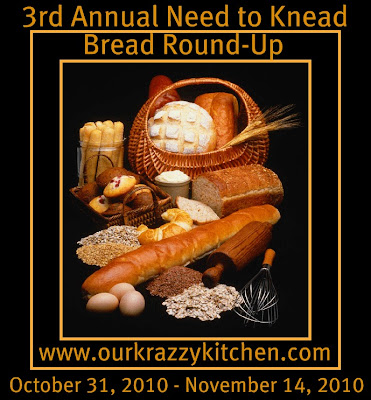The (3rd Annual) NEED TO KNEAD has moved to OUR KRAZY KITCHEN.
We all have some favorite family bread recipes tucked away.
I know that at certain times I have the NEED TO KNEAD, primarily during the holidays or from October through April, those long cold months of winter. The rest of the time my Bread Machine Rules.
I thought we could all come together and share our daily bread recipes.
And I mean all breads! White, wheat, banana, braided, etc… whatever you’re in the mood to share.
Ironically National bread month is November at the beginning of our holiday baking crunch.
Just post your recipes anytime until November 15, 2010, go over and link up at OUR KRAZY KITCHEN so that we can all visit you. You can even link to recipes you have previously posted. Add this button to your participating posts and link to this blog. Your blog can be in any language, but a translator on your site will help any who don’t speak the same language.
Bread History According to National Bread Month:
..”It was only after the Pilgrims came to America that baking bread in private homes became the norm. Our ancient forbearers baked bread in communal ovens. These ovens were built on the out skirts of villages, near water due to the extreme fire hazards of the early brick ovens. Later in Europe, after the Romans taught the indigenous peoples about bread making, bread was still baked in large ovens. Except these ovens were not communal ovens they were owned, as was the mill, by the local lord. This made families dependant on the lord for their daily bread. By the Middle Ages baking guilds controlled who and how bread were baked and sold. These organizations limited the number of bakers and bakeries in each village and that meant even impoverished peasants had to purchase bread.
Bread is one of the oldest prepared foods, dating back to the Neolithic era. The first breads produced were probably cooked versions of a grain-paste, made from ground cereal grains and water, and may have been developed by accidental cooking or deliberate experimentation with water and grain flour. Descendants of these early breads are still commonly made from various grains worldwide, including the Mexican tortilla, Indian chapatis, rotis and naans, Scottish oatcake, North American johnnycake, Middle Eastern Pita bread (Kmaj in Arabic and Pitot in Hebrew) and Ethiopian injera. The basic flat breads of this type also formed a staple in the diet of many early civilizations with the Sumerians eating a type of barley flat cake, and the 12th century BC Egyptians being able to purchase a flat bread called ta from stalls in the village streets.
http://en.wikipedia.org/wiki/Bread


Have you heard about the Need to Knead Bread Roundup? The need to knead bread round-up is almost here. I thought maybe it was time to share with you some food for thought (Pun intended) with a few great resource sites for baking.
General Tips to remember:
- Baking in a high place, a dry place or in a place that can have sudden changes in barometric pressure. All these factors can alter how yeast breads knead, rise and bake.
- To determine if your yeast is still active, dissolve 1 tsp. sugar in 1/2 cup lukewarm water in a see-through measuring cup. Sprinkle 1 tbsp. yeast slowly over the water. Stir and let stand for 10 minutes. At the end of this time, the yeast should have foamed up to reach the 1 cup mark. Yeast that does not reach this mark in 10 minutes will not produce a good loaf and should be discarded.
- Water can replace milk. The texture will change a little, but the bread will still be very tasty and good to eat.
- White sugar, brown sugar, honey and molasses can be interchanged equally in bread dough. The sugar in bread dough supplies the tiny yeast plants with instant food and gets them off to a fast start. Artificial sweeteners are not recommended for yeast breads because they cannot be used by the yeast as natural sweeteners can.
- Fats can be replaced with applesauce or prune puree. The texture of the bread will be more dense. A general rule of thumb is to substitute 1 1/2 tablespoons of applesauce/prune puree for every 3 tablespoons of fat.
- Salt is added to yeast breads not only for flavor but also to keep the yeast fermentation in the bread dough under control. Too little salt will allow the yeast to push the dough so high that it may even collapse. Too much salt will keep the dough from rising enough.
In preparation for the upcoming National Bread Month in November and for our driving desires and “NEED TO KNEAD” as well as the upcoming Holidays let’s all join in together on October 31st, 2010 to November 15, 2010 and round-up all of our delicious bread recipes to look back on when we need to bake fantastic bread. I know many of mine were handed down by my grandma.
~ We are looking for all sorts of breads: quick breads, savory breads, sweet ones, yeast breads, no-knead breads, 5-minute breads, vintage or gluten-free breads, etc, etc, etc!
~ Help us promote this bread roundup by putting the above banner in your sidebars and posting about the 3rd Annual Need to Kneed Roundup on your own blogs.
~ We would love it if you would join us, and we would love it if you would help us spread the word by putting this button in your sidebars or even writing a short post about the roundup. Post your links from October 31, 2010 to November 15, 2010 for all your bread recipes.
~ Have fun blog hopping through the bread recipes, make new friends, find new family-favorite recipes, comment, enjoy the process of community-building.

















